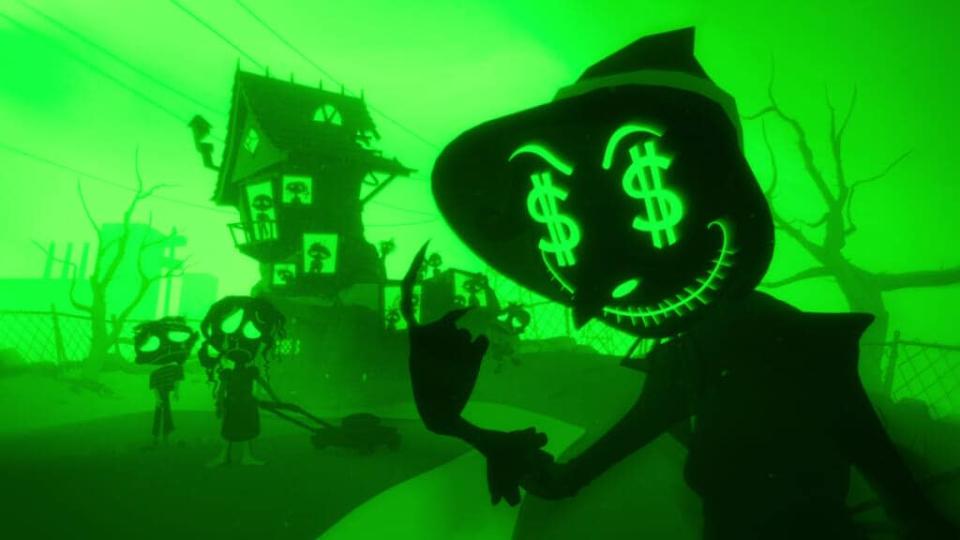Henry Slick is back with a new, original animated feature called “Wendell & Wild.” Incredibly, this film (out October 28 on Netflix) is his first since “Coraline” back in 2009. For a while it seemed like Selick, whose singular genius was responsible for “The Nightmare Before Christmas” and the animated intrudes in Wes Anderson’s “The Life Aquatic” (among other things), would never make another movie. Thankfully that isn’t the case.
“Wendell & Wild,” based on an original idea of Selick’s, concerns two demons (voiced by Jordan Peele and Keegan-Michael Key) who work in a hellish theme park amongst the “souls of the danged” (according to Selick they aren’t quite as bad as the souls of the damned). Together, the demons attempt to utilize a human child named Kat (voiced by Lyric Ross) as their ticket to the land of the living. Imagine “Beetlejuice” but with a wider variety of influences (including, crucially, Afro-Punk music) and, you know, entirely animated in stop-motion.
After talking with Selick, the existence of “Wendell & Wild” feels like a miracle. The story of how it came to be is just as frightful as anything Selick could have dreamed up.
What Happened to Selick’s Pixar Projects
“Coraline,” since it was the last feature project that Selick completed, is as good a place as any to start when it comes to explaining where the director has been for the past decade. Based on the novel by Neil Gaiman, “Coraline” was released in February 2009. It was warmly received by critics and wound up a modest box office hit, grossing more than $100 million on a $60 million budget. It also formally announced the arrival of LAIKA, a stop-motion animation studio based in Portland, Oregon (it was formerly known as Will Vinton Studios), as a major player. It was assumed that Selick would stick around LAIKA, since they shared his dedication to stop-motion and his somewhat macabre sensibilities.
Also Read:
The 7 Best New Movies on Netflix in September 2022
But a year later, in an unprecedented move, Disney announced a long-term deal with Selick, along with two feature projects – an original stop-motion film called “Shademaker” (later retitled “The Shadow King”) and an adaptation of Neil Gaiman’s “The Graveyard Book” (a riff on “The Jungle Book” but with monsters instead of giant cats). What’s more, Selick’s stop-motion unit, known as Cinderbiter, would be a subsidiary of Pixar. The warehouse where production would take place wouldn’t be far from Pixar’s sprawling campus in Emeryville. (“The Nightmare Before Christmas” was also produced in the bay area.) It would also reunite Selick with his old CAL Arts chum John Lasseter. Sadly, this wasn’t meant to be.
“We developed it pretty far, we went into production, had shot about five minutes, and they went through a big a shuffle, a big change, at Disney,” Selick told TheWrap about how far “The Shadow King” got. “Two things: the budget kept going up, because John Lasseter couldn’t help but come in and change everything every few months, because that’s who he is, and maybe that’s how the best work has been done there. At the end of the day, it was costing too much and it was stop-motion. It was a little weird and they decided to pull the plug. Never saw it coming, but it was also a relief, because to constantly start over and over and over while you’re trying to give people work to do out on the stage, was a challenge.”
The fact that the project was stop-motion, which was the major selling point (interestingly Pixar had attempted to buy Will Vinton Studios before it became LAIKA) was now a liability. The feature became a bug. “There had been three stop-motion films that had come out right before that. ‘Frankenweenie’ was the last of them,” Selick explained. “None of them were very successful at the box office, so it was decided. It happened with me before, it probably will again. Stop-motion, why would we take a chance on this ancient technology?”


Of course, death of what would be known as “The Shadow King” would also impact “The Graveyard Book,” which in the years since Selick’s deal began has cycled through a number of filmmakers (currently Marc Foster is attempting to bring it to life). “That went away as well, but they still never cracked it,” Selick said. (He claims he did crack it and knew how to tell the story.) Disney publicly announced an $80 million write-down on the projects and returned the rights to “The Shadow King” to Selick. He never found someone who was interested in finishing the project.
“As far as what I went through, it took a long time to get back on my feet to try to get something else going again. I just felt, Wow, if they’ll shut down a movie when you’ve already started… That was something I couldn’t have imagined,” Selick said. “It just made me really leery of trying to do something else.”
That is, until he met Jordan Peele.
Also Read:
‘Nope’ VFX Supervisor Reveals Secrets of Jordan Peele’s Horror Epic: From Gordy to Jean Jacket
The Big Comeback
Before “Get Out,” Selick had met with Peele, who was in the process of establishing his production company, Monkeypaw. Selick pitched a few ideas, including one idea that Selick had originally thought might make a good book – the idea that would eventually become “Wendell & Wild.” At first, Peele was anxious to set the movie up before he filmed “Get Out,” unsure of whether the movie would connect with audiences and worried that he might be squandering his one chance at directing. Oh how wrong he was. Peele would win the Oscar for Best Original Screenplay (it was also nominated for Best Picture and Best Director) and the film made more than $255 million on a budget of $4.5 million. Last year the Writer’s Guild of America named Peele’s script for “Get Out” the best screenplay of the 21st century.
“There were two main things that were in our favor,” Selick said. “‘Get Out’ was great and it was a huge hit, so everyone wanted to be in business with him. We had a good tailwind, but more importantly, we didn’t go to many places, because we knew everyone wants to meet Jordan about anything, but there really were only going to be a few places who would take a chance on an unusual film like this. Netflix was one of them and they said all the right things. They said, ‘We don’t just develop films. If we like your project, if we like you, when we say ‘Yes’ it’s basically a green light that we will make this film.’” Selick added: “We did go to hell and back, but they held true. They made the film, they supported the film.”
Selick admits that “there were plenty of bumps along the way” in the production of “Wendell & Wild,” chiefly that they had secured their deal before Netflix had formally installed animation executives at the company. When the new executives came in, largely comprised of former DreamWorks employees, they were somewhat shocked at the deal Selick and Peele had secured. They were particularly startled by the movie’s PG-13 rating. “They just couldn’t imagine that an animated film would work as PG-13, but they worked hard at adjusting. The collaboration was rough at first, but we got to a really good place,” Selick said. “It only took a year, but we got in tune with each other, in terms of studio creativity.”
Also Read:
7 Spooky Netflix Shows to Watch to Kick Off the Fall Season
Not that there weren’t disagreements. “One of the biggest fights I had with the studio was… They kept saying, ‘Couldn’t you have Kat smile a little earlier in the film?’ I said, ‘No, that’s not who she is. She can’t do that until she’s in another place and she will be. That just betrays who she is,’” Selick said. (Kat’s parents are killed in a car accident early in the film.) “She’s a badass, and she’s got a reason to be,” Selick said.
When I asked if he had ever considered making “Wendell & Wild” an R-rated movie, since Netflix has an adult animation division, he said no. “The story itself didn’t lend itself to that and that seemed like a bridge too far,” Selick said. “Other stories might work well within an R-rating, but this one didn’t need it.” His personal philosophy when working on projects like “Wendell & Wild” is to “scare, not scar” his younger audiences.
Earlier this year another new executive, Karen Tolliver, was brought on to oversee all of Netflix’s animation output, formerly of Sony Pictures Animation. “She had some strong ideas about the music, about the songs, and I was just like, I want to be done, I’ve been on this show for so long, but she’s smart and they were really good ideas,” Selick said. “They spent more money and we were able to bring back some needle drop songs that we had had to lose, because they weren’t free.”
After a test screening for “Wendell & Wild” “knocked it out of the park” with a certain age group (10 to 14), they spent another month-and-a-half “recutting and shifting,” according to Selick, to make it more accessible to an older age group. “It really helped the film,” Selick said.
There was also the pandemic.


Much has been written about how computer-animated projects like Disney’s “Turning Red” or “Encanto” were mostly completed at home, with artists toiling away in their kitchenettes or living rooms to make it to the finish line. “Wendell & Wild” didn’t have that luxury. “We have to shoot stuff on a stage, so we had to shut down. We did what work we could from home, but then we finally reopened the studio, and all that stuff. The masks, the social distancing, and no more than this many people in.” Selick said that stop-motion is a challenging enough way to make a film and that the pandemic (and the precautions associated with the pandemic) just added to it. There were also, he noted “a few other natural disasters we faced,” including a runaway forest fire.
Selick produced “Wendell & Wild” in the Portland area (near where “Coraline” was produced), a place where forest fires are becoming more prevalent. “We had a forest fire that was getting so close, we had to evacuate the puppets,” Selick said, referring to the characters in the movie. (Each one is a “puppet” with a metal skeleton that is manipulated, one frame at a time. Just like Ray Harryhausen used to do it.) “We thought, It’s coming closer and closer, if the studio burns down, what do we need to keep in order to still make the film,” Selick said. Then they realized: “All the puppets, because they’re very expensive, take a lot of time to build, and they’re our actors.” The puppets were loaded into cars and driven “away to safety.” The fire fizzled before it hit the studio and the puppets were safe. Whew.
An Uncertain Future
Before talking to Selick, he did a presentation about “Wendell & Wild.” Towards the end of the presentation he said something that struck me. It was a simple phrase. But it made my blood run cold. “If I make another movie,” Selick said, before elaborating on some other topic. I brought this up to him. The world needs more Henry Selick movies. And he turns 70 in November.
“It’s always been a battle. I mean the first one wasn’t, because it was a gift to Tim Burton,” Selick said, referring to “The Nightmare Before Christmas.” Burton was a former Disney animator who had left the studio and made it big with hits like “Batman” and “Beetlejuice.” Disney wanted him back, so they asked if he wanted to expand a concept he had originally worked on at the studio (and which Disney still controlled): a holiday special in the style of the old Rankin/Bass productions. Burton agreed and installed Selick as the director. The resulting film was so dark that Disney removed their name; it was initially released as a Touchstone Pictures film. In the years since it has become one of the most beloved properties in Disney’s vast library; a Halloween stage show at Walt Disney World has “Nightmare Before Christmas” character Zero interacting with Mickey, Goofy and Donald.
“We did it for a pretty low budget and I was protected. I would get notes and I’d say, ‘Tim, what do I do?’ He said, ‘If you like it, do it. Otherwise, ignore it.’ I thought that’s how life would be. For my first film, we got total artistic support and I thought it would always be that way,” Selick said. “It didn’t happen again until I did ‘Coraline.’” Selick’s next project for Disney, a mostly stop-motion adaptation of Roald Dahl’s “James and the Giant Peach” (featuring striking design work by children’s book illustrator Lane Smith), was constantly second-guessed. And by Selick’s own admission, on his big budget hybrid project “Monkeybone” starring Brendan Fraser (this time for Fox), he “crashed and burned.” “Only in ‘Coraline’ did I get that full artistic support and I know that, when I get it, my work is better and it’s more successful,” Selick said.
Also Read:
The 7 Best New Movies on Hulu in September 2022
Selick doesn’t sound like he demands artistic support and the freedom to do what he wants. He never comes across as temperamental or blustery. He just feels like, if he did a good job with minimal supervision that he would be allowed the same luxuries on the following project. “After ‘Coraline,’ I couldn’t get that support again, because of the team I was working with, so it took forever to get another film up and going. I look back to ‘Coraline,’ I would’ve thought I should’ve easily been able to make my film after that. It turned out not to be the case,” Selick said. “With this film currently, we have to see, how does the world respond to it?”
As of now he still has the rights to another Gaiman project; he wouldn’t tell me which one but said it was “based on his best book.” (My best guess is “Neverwhere.”) He’s hopeful that he will remain in partnership with Netflix too, even though he admits “they’re going through upheaval, adjustments and changes.” Gaiman has more cache than when Selick made “Coraline,” something that the director is keen to take advantage of. “He’s actually learned to navigate the system and he’s a filmmaker now. He brings a lot of oomph to it,” Selick said. “Right now, let’s wait and see how the world responds [to ‘Wendell & Wild’].”
What is very clear is that what happened at Pixar still affects him – and how he approaches projects even now. “I can’t go through what I had to go through after ‘Coraline,’ to be shut down,” Selick said. “How do you know, once you start a film, Are they going to let me finish it?”
Finally, Selick concedes: “I could tell a few more stories. I’ve got a couple of things, but I’m not counting on them. We’ll see.” Like all of Selick’s movies, the statement is somewhat uplifting but still couched in sadness, tinged with melancholy. And really, what more could you want?
“Wendell & Wild” streams exclusively on Netflix on October 28.
Also Read:
How ‘Honk for Jesus. Save Your Soul’ Filmmakers Used Satire and Documentary to Examine Truth




